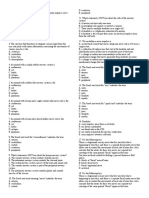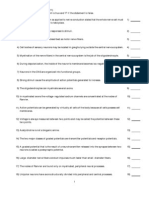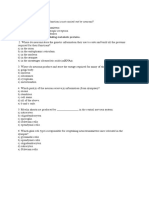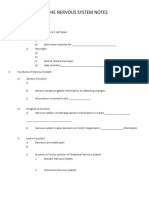CHAPTER 7
THE NERVOUS SYSTEM: NEURONS AND SYNAPSES
Multiple Choice
___ 1. Which of the following is not a function of neurons?
a. respond to physical and chemical stimuli
b. conduct electrical impulses
c. release specific chemical regulators
d. All of these are neuron functions.
___ 2. Nissl bodies of the perikaryon are composed of
a. mitochondria
b. rough endoplasmic reticulum
c. Golgi apparatus
d. lysosomes
___ 3. A grouping of cell bodies located within the CNS is known as a
a. tract
b. nerve
c. nucleus
d. ganglion
___ 4. Involuntary effectors (glands, smooth or cardiac muscle) are innervated (stimulated) by
a. autonomic nerves
b. efferent nerves
c. motor nerves
d. All of these nerves innervate involuntary effectors.
___ 5. The most common type of neuron (motor neuron, for example) is
a. bipolar
b. multipolar
c. pseudounipolar
___ 6. Myelin sheaths around axons within the CNS are formed by
a. Schwann cells
b. microglia
c. astrocytes
d. oligodendrocytes
___ 7. The most abundant supporting (glial) cell in the CNS, which forms end-feet around capillaries
associated with the blood-brain barrier, is the
a. astrocyte
b. oligodendrocyte
c. satellite cell
d. microglia
___ 8. The supporting cells of the nervous system that line the ventricles (cavities) of the brain, that
form choroid plexuses producing cerebrospinal fluid (CSF); and more recently that seem to
function as stem cells (able to divide and differentiate into new neurons and neuroglial cells),
best describes the
a. astrocyte
b. oligodendrocyte
c. satellite cell
d. microglia
e. ependymal cell
___ 9. Which statement about Schwann cells is not true?
a. They remain alive as their cytoplasm is forced to the outside of the myelin sheath.
b. They have extensions, like tentacles of an octopus, that form myelin sheaths around several
axons simultaneously.
This study source was downloaded by 100000859596816 from CourseHero.com on 12-22-2022 15:19:34 GMT -06:00
https://www.coursehero.com/file/37141751/Review-questions-chapter-7pdf/
� c. Adjacent cells have gaps exposing nodes of Ranvier along an axon.
d. They are only found in the peripheral nervous system (PNS).
e. They can form a regeneration tube, helping to reconnect and reestablish nerve function after
an axon has been cut.
True or False
___ 19. F The myelin sheaths around axons of the CNS give this tissue a gray color and thus form gray
matter.
___ 20. T Myelinated axons conduct impulses more rapidly than those that are unmyelinated..
___ 21. T Astrocytes surround capillaries of the CNS using their end-feet to uptake such substances as
K+, glutamate neurotransmitters, and glucose from the extracellular fluid.
___ 22. F Spaces (pores) are found between endothelial cells lining the capillaries of the brain, and thus
form the blood-brain barrier.
Multiple Choice
___ 23. When a cell is stimulated and more negative charges flow into the cell so that the cell becomes
more negative than the resting membrane potential, describes
a. depolarization
b. repolarization
c. hyperpolarization
___ 24. The term “voltage regulated” means that the membrane
a. gates open and close with changes in the membrane potential
b. potential is controlled by the Na+/K+ pumps
c. will not respond unless electrically stimulated
d. potential can only be seen with an oscilloscope
___ 28. Action potentials conducted without decrement means conducted without
a. decreasing its velocity
b. altering the threshold potential
c. decreasing its amplitude
d. altering the Na+ or K+ concentrations in the neuron
___ 29. Which of the following statements about the conduction velocity of action potentials along
myelinated axons when compared to that along unmyelinated axons, is false?
a. Conduction velocity in the myelinated axon is very fast, approaching 225 miles per hour.
b. Cable properties within the myelinated axon increase the conduction velocity.
c. Nodes of Ranvier increase the conduction velocity.
d. Saltatory conduction increases the conduction velocity.
True or False
___ 30. T Although all cells have a membrane potential only a few types of cells, such as neurons and
muscle cells, demonstrate the ability to respond to stimulation - a property called excitability or
irritability.
___ 31. F Following stimulation of a neuron, positive charges flow into the cell causing depolarization,
whereas the return to resting is known as hyperpolarization.
This study source was downloaded by 100000859596816 from CourseHero.com on 12-22-2022 15:19:34 GMT -06:00
https://www.coursehero.com/file/37141751/Review-questions-chapter-7pdf/
� ___ 32. F There may be two types of membrane channels for Na+; one type is always open because it
lacks gates, whereas the other type has gates that are closed at rest.
___ 38. F The action potential generated at the end of the axon looks different from that formed at the
axon nearest the cell body.
___ 39. T Action potentials conducted along thicker, unmyelinated fibers are conducted faster than
those along thin, unmyelinated fibers; and are substantially faster if the axon is myelinated.
___ 40. F Thick myelinated fibers would be expected to mediate (to come in the middle of or to control)
slow responses in the viscera (to and from internal organs and smooth muscle).
___ 41. T Saltatory conduction of action potentials is made possible by the interruptions in the myelin
sheath along axons, known as nodes of Ranvier.
___ 45. The ion that must flow into the presynaptic neuron ending to activate the release of
neurotransmitter chemicals from synaptic vesicles is
a. sodium
b. potassium
c. calcium
d. iron
e. hydrogen
True or False
___ 47. T Myoneural and neuromuscular junctions mean the same thing - that is, they refer to a neuron-
to-muscle synapse.
___ 48. F Synaptic transmission is electrical rather than chemical.
Multiple Choice
___ 53. Acetylcholine (ACh) is a neurotransmitter released from all these neurons except
a. specific CNS neuron endings
b. somatic motor neurons at the neuromuscular junction
c. specific autonomic neuron endings
d. All of these neurons release ACh.
___ 54. Which of the following is not a property of chemically regulated gated channels?
a. They respond best to membrane potential changes.
b. They are located on the postsynaptic membrane.
c. They can allow Na+ and K+ diffusion simultaneously through opened ion channels .
d. They are activated by neurotransmitters binding to specific receptor molecules.
___ 55. Which of the following statements describes nicotinic receptors (as opposed to muscarinic ACh
receptors)?
a. These receptors are formed from only a single subunit.
b. These receptors activate G-proteins located in the cell membrane.
c. These receptors do not contain an ion channel.
d. Once opened, for example, can permit the outward diffusion of K + and hyperpolarization.
e. Once opened, for example, can permit the inward diffusion of Na + and depolarization.
This study source was downloaded by 100000859596816 from CourseHero.com on 12-22-2022 15:19:34 GMT -06:00
https://www.coursehero.com/file/37141751/Review-questions-chapter-7pdf/
� ___ 56. Acetylcholinesterase (AChE) is an enzyme located on or immediately outside the
a. presynaptic membrane
b. postsynaptic membrane
c. axon terminal cytoplasm
d. vesicles released by exocytosis
___ 57. The drug curare reduces the size of end plate potentials on the membrane of muscle fibers by
a. competing with ACh for attachment to the receptor proteins
b. blocking the release of ACh from presynaptic vesicles
c. enhancing the breakdown of ACh by the enzyme, AChE
d. blocking the flow of Na+ through open ion channels
True or False
___ 62. T The effects of acetylcholine (ACh) can be either excitatory or inhibitory.
___ 63. F ACh is transported into the postsynaptic cell cytoplasm, where it produces its effects.
___ 64. T Neurotransmitters operating chemically regulated gates, do not directly result in action
potentials, but rather initially produce EPSPs and IPSPs.
___ 65. T Acetylcholinesterase (AChE) is an enzyme that inactivates ACh, thus serves to uncouple the
.
Multiple Choice
___ 101. EPSPs produced by many different presynaptic fibers converging on a single postsynaptic
neuron, causing summation on the postsynaptic dendrites and cell body, best describes
a. synaptic plasticity
b. temporal summation
c. synaptic inhibition
d. spatial summation
___ 102. Inhibitory postsynaptic potentials (IPSPs)
a. result in hyperpolarization of the postsynaptic membrane
b. may be caused by opening postsynaptic K+ gates
c. may be caused by opening postsynaptic Cl- gates
d. lower the membrane potential; more negative than resting
e. All of these statements regarding IPSPs are correct.
This study source was downloaded by 100000859596816 from CourseHero.com on 12-22-2022 15:19:34 GMT -06:00
https://www.coursehero.com/file/37141751/Review-questions-chapter-7pdf/
Powered by TCPDF (www.tcpdf.org)
























































